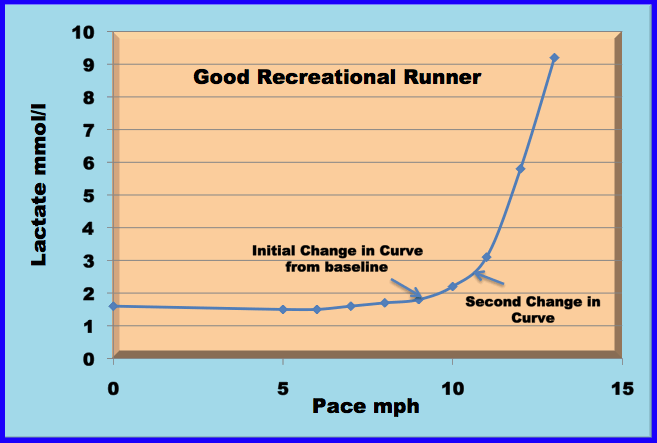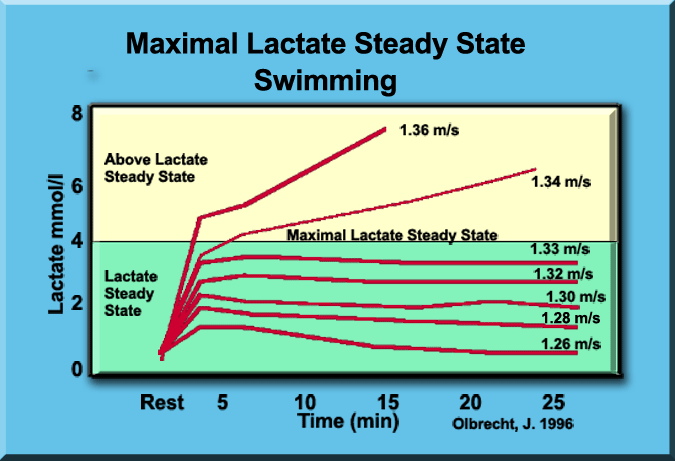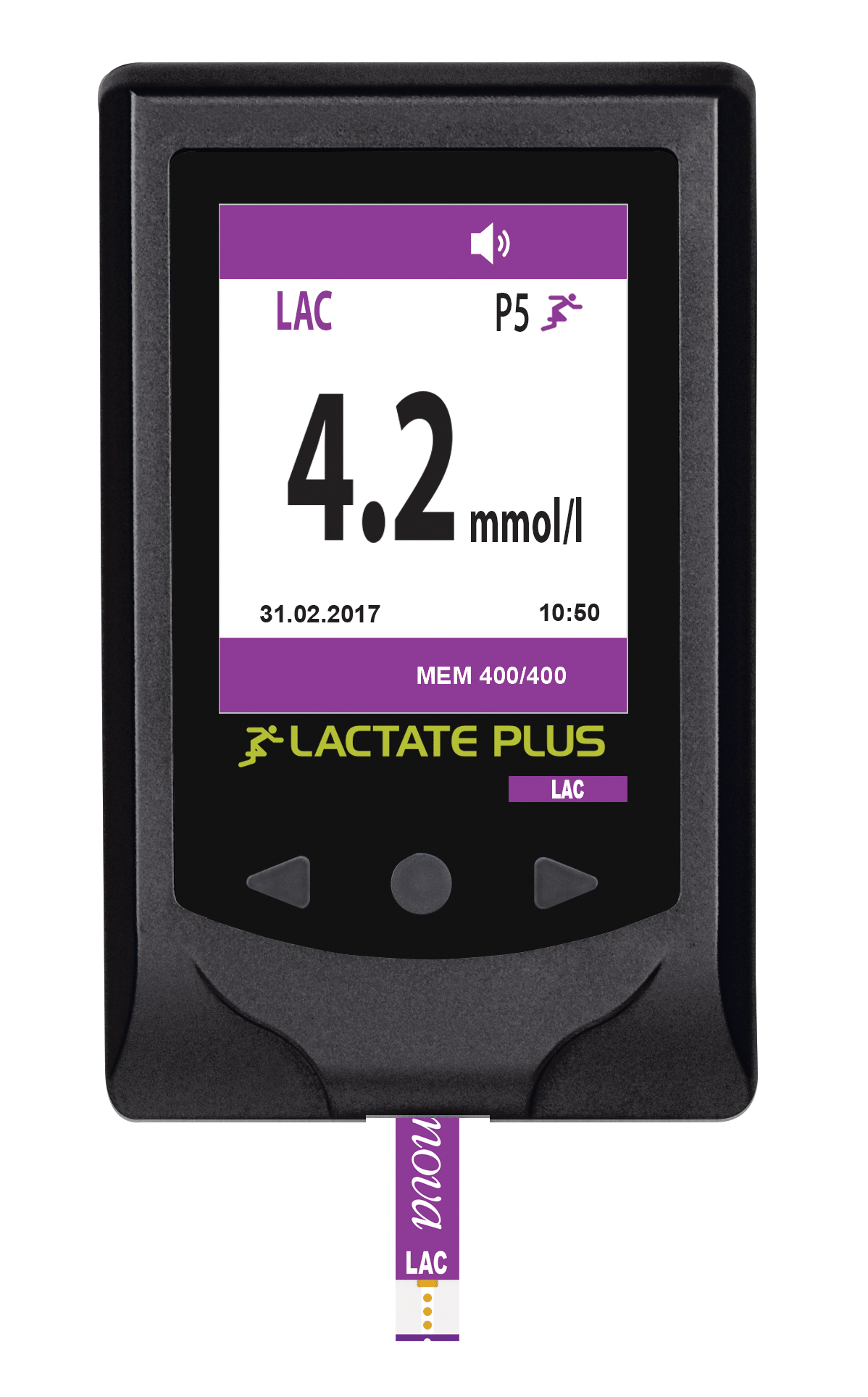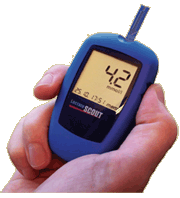Thresholds - Lactate Testing
This topic is brief discussion of the origin of thresholds in exercise science from the Secrets of Lactate Course - we have put part of it here for all who are interested.
Also click here for an extensive discussion of the lactate threshold.
What is the anaerobic threshold?
We begin the discussions of thresholds with the anaerobic threshold because this is term that started the cascade of discussions on thresholds in the training and exercise metabolism literature.
It should be pointed out that there is no clear consensus on what this term now means. It had a specific original meaning but almost no one uses it for this original meaning. Also the person who named it was not the first person to have discovered the physiological event that it described. That was Wildor Hollmann in 1959 from the Sports School in Cologne Germany who identified what he called the "point of optimum ventilatory efficiency" corresponding to a abrupt increase in the use of oxygen and the elimination of carbon dioxide during an oxygen test of athletes. (As of 2020 Dr. Hollmann is still living and considered one of.the top researchers of the 20th century in exercise science.)
In 1964 Karlman Wassermann of Stanford University identified. the same phenomenon that Hollmann did five years previously and published his results in the American Journal of Cardiology. He called this change in ventilation patterns the anaerobic threshold. Hollmann was mostly unknown in the English speaking world thus the credit of this discovery is usually attributed to Wasserman and the term definitely originated with Wasserman. Hollmann was not cited in Wasserman's paper.
This is the first use of the term, "threshold" that we know of in the literature relevant to changes in exercise intensity. Just what this discovery meant was mainly speculation 50-60 years ago since they did not know much about exercise metabolism. The primary question was did this change in oxygen and carbon dioxide patterns describe anything important in terms of health or exercise science? As we will see this was then and still is a controversial area.
Originally (in the period from the mid 1950's to the mid 1970's) some sports scientists thought that there was a point of exertion where the body started to use anaerobic energy heavily due to limitations of oxygen. The point discovered by Hollmann corresponded to a sudden change in the patterns of carbon dioxide elimination during exercise as well as a rise of lactate in the blood and he speculated that there was a change to anaerobic energy because of the increase in lactate.
Because it was an abrupt change, like the passing from one physiological state to another so did Wasserman believe that this was a point where anaerobic energy increased markedly. Thus, he called this physiological change a threshold and also anaerobic.
It was an unfortunate choice of terms since it probably has led a lot of sports scientists, researchers and coaches down the wrong path. Many are still on this wrong path. Anaerobic is not appropriate since anaerobic energy is produced even at resting levels way below the point that was being designated the anaerobic threshold. As exercise gets a little harder but still very much below the point that was designated as the "anaerobic threshold" by Wasserman, anaerobic energy increases even though very little additional lactate if any showed up in the blood. (When lactate is produced and what determines the level in the blood is discussed at other parts of this website.)
A few years after the Wasserman article the use of the term "anaerobic threshold" changed to describe another physiological phenomenon (see a time line of threshold concepts below.) Since then it has taken on several other meanings. So when we define the anaerobic threshold today, the reader should know that others may use a different definition.
To show the absurdity on how. this term has been used, here are some different definitions for anaerobic threshold. They represent the output of serious researchers but they have little to do with how the term is usually used now.
AT has been defined as the point at which there was 1) a nonlinear increase in ventilation, 2) a nonlinear increase of the arterial blood lactate level, 3) a nonlinear increase in CO2 production, 4) an increase in end-tidal 02, 5) an increase in RQ, 6) an arterial lactate level of 4 mmol/l, 7) an abrupt increase of FEO2 (average expired 03 fraction), 8) an increase of end-tidal 02 partial pressure (PET02) without a decrease of end-tidal CO2 partial pressure (PETCO2), 9) a nonlinear increase in the integrated electromyogram (IEMG), 10) at which running speed vs heart rate departs from linearity, 11) the point where 4.0 mol/l of lactate is reached during a graded exercise test.
Many sports scientists would prefer to eliminate the term altogether. However, it is still commonly used by coaches, training books, the popular press and many sports scientists. As we are editing this course in 2020 an article appeared on the internet titled "TEN THINGS YOU NEED TO KNOW ABOUT THE ANAEROBIC THRESHOLD" and we agree with little in the article.
The Baseline
If the athlete is well conditioned, most of the pyruvate produced by the anaerobic system is utilized immediately for aerobic energy. In these athletes there will be little indication of increased lactate production even though the anaerobic system is being actively utilized. (consult discussions of energy production in this course)
In the chart below notice the long line called the baseline where the lactate level does not change. The change in ventilation discovered by Hollmann and Wasserman was often near the first place on the lactate curve that started to rise. Thus, a lot of researchers conflated the two ideas, a rise in lactate with a change in ventilation, as describing the same phenomenon. It should be noted that the two phenomenon are probably related in some ways.
Also beyond the point that was originally designated as the "anaerobic threshold" (described on the chart below as the initial change from the baseline) there was still a steady increase in the use of aerobic energy while the lactate levels rose by small amounts. Also the athlete remains in a steady state and often feels the effort level is still easy.
Later on in the mid 1970's it was understood that there was another point above what was then called the anaerobic threshold that was more important (see chart below for the two points.) This second point at a substantially higher effort level was where lactate no longer remained in a steady state and increased till the athlete had to stop or slow down. The term anaerobic threshold was then applied to this higher effort level by some and the lower level was designated something else (some called it the aerobic threshold and many called it the lactate threshold and a few still called it the anaerobic threshold.) It is now usually referred to as the ventilatory threshold though many still call it the lactate threshold.
Thus, the use of the term "anaerobic threshold" is not only a misnomer but confusing. It is a misnomer because there is no sudden switch to anaerobic metabolism and there certainly is a continued increase in the use of aerobic energy at either the lower point or even at the higher point. Something completely different is happening at these two points. It is also as we said confusing because the different uses of the various threshold terms.

A Quick History of Thresholds?
- In 1959 Wildor Hollmann of the German Sports University in Cologne presented a paper on what he called "point of optimal ventilatory efficiency" at the Third Pan American Congress of Sports Medicine. The presentation was based on the author's hypothesis that the ventilatory phenomenon and lactic acid production changes at this point were due to important changes taking place in the muscles. Subsequent research has shown that this is not the case.
- In 1964 Wasserman and McIlroy used the term "anaerobic threshold" to describe similar phenomena and the term "threshold" became popular internationally.
- In 1965 Monod and Scherrer introduce the concept of "critical power" and showed that there was a relationship between power output and time to exhaustion. CP was identified as the maximum rate that could be sustained 'for a very long time without fatigue. This is essentially the same as a maximal steady state based on lactate that would be discovered 6 years later by Mader.
- In the early 1970's, Alois Mader, was working with runners in East Germany and discovered that when these runners used a pace faster than the one that generated slightly more than 4 mmol/l of lactate in a progressive exercise test that they quickly became exhausted. When the runners ran at a slightly slower pace they were able to continue running for an extended period of time. Mader escaped from East Germany and went to work with Hollmann at the German Sports University in Cologne and popularized the 4 mmol/l lactate measurement in a journal article published in 1976. It should be emphasized that the 4 mmol/l level is much higher effort than the one where Wassermann or Hollmann proposed in their studies.
During this time the term "aerobic-anaerobic" threshold was being applied to the 4 mmol/l level by some. - In the late 1970's and early 1980's a German researcher, Kindermann recommended that the the term "anaerobic threshold" be used to describe the effort level that generated 4 mmol/l of lactate. And the "aerobic-anaerobic" refer to the the effort levels that generated between 2 and 4 mmol/l of lactate.
- In early 1981 Lafontaine published an article titled "The maximal steady state versus selected running events"
- In 1981 Moritani found that the critical power was correlated with the anaerobic thireshold as defined by Wasserman.
- In 1981 Stegmann demonstrated that the maximal amount of lactate that could be maintained over a period of time varied by individual and that as the aerobic capacity increased this level decreased. He called his threshold the Individual Anaerobic Threshold or IAT. An important implication is that this threshold varied in amount of lactate in the blood and thus, undermined the concept of 4 mmol/l of lactate as a threshold.
- In 1981, Bertil Sjodin, a researcher at the Karolinska Institute in Stockholm and a Canadian Ph.D. student there named Ira Jacobs, used the term "onset of blood lactate accumulation" or "OBLA" to refer to effort level in runners that corresponded to the point at which blood lactate begins to increase exponentially. A blood lactate level of 4 mmol/l was associated with this point and in most instances today "OBLA" means a 4 mmol/l blood lactate concentration. OBLA is not commonly used anymore but still pops up in journal articles and in some popular literature.
- In 1982 Stegmann uses the term "maximum lactate steady state" in a journal article.
- All these researchers quickly realized that the lactate level at which this threshold took place varied substantially between athletes while the myth has persisted till today that they said the 4 mmol/l level was the actual threshold level. It is true at first that this was thought but since 1981 or about 40 years ago, researchers realized this was not true.
- In the early 1980's Heck and Mader at Cologne investigated an alternative model of exercise metabolism that explained what was causing these thresholds. They first published their results in 1985. Their research and its continuation by Mader remains the best explanation for the thresholds. It is essentially ignored by nearly all of the exercise science community. Mader is still alive today in 2020 and continues to work on his exercise metabolism models. His ideas are gaining more acceptance today as his ideas have been incredibly successful in training high level athletes.
- In 1985, Jan Olbrecht, a student of Mader, published an article on what he called the T30. It was either a 30 minute swim or a 3000 m swim. The pace at which the swim took place was used to approximate the effort level at the MLSS. Olbrecht, while the designer of the test, rejected it as useful because it did not explain what was behind the result or the MLSS. Ironically 20 years later this idea was taken up by cycling coaches who named it the Functional Threshold.
- In 1989 Olbrecht showed that two athletes with identical threshold numbers had very different metabolisms and when trained identically the athletes reacted very differently to the training stimulus. Olbrecht showed that the two athletes had different aerobic and anaerobic capacities and that the training was utilizing the aerobic and anaerobic systems very differently during workouts. One of the athletes was being over-trained while the other thrived. These results were ignored by most of the exercise science community and still are today.
What is the currently accepted use of the term "anaerobic threshold"?
The most common use of the term "anaerobic threshold" is to describe a phenomenon that takes place in all athletes - namely the maximal speed or effort that an athlete can maintain and still have no increase in lactate. At this speed or effort, lactate levels in the blood remain constant. Any increase in effort or speed above this level will cause lactate and its associated high acid levels to increase steadily. This will eventually force the athlete to slow down or stop. The time to cessation or slowing down will depend upon how far the athlete is above the maximum steady state effort, the event the athlete is competing in, the type of athlete (strength or endurance) and conditioning. So the anaerobic threshold is the same thing as the MLSS for many.
It is possible for the athlete to exceed the anaerobic threshold level by small amounts and still exercise or compete for a substantial period of time, sometimes up to 25-30 minutes. The lactate levels will gradually increase in the blood but will not stop exercise for this time. However, substantial increases above the anaerobic threshold will usually shut down the athlete very quickly, often in as little as 20-40 seconds.
The following chart illustrates the concept of a maximal lactate steady state. The swimmer below is able to maintain 1.33 m/s with a constant lactate level of about 3.8 mmol/l. At 1.34 m/s the swimmer is able to continue for an extended time as lactate slowly builds up and finally stops between 20 and 25 minutes. At 1.36 m/s the swimmer stops after 15 minutes. The maximal lactate steady state lies somewhere between 1.33 m/s and 1.34 m/s. For practical purposes it is assumed that the lactate threshold or maximal lactate steady state is 1.33 m/s.

What other terms are used to express this concept?
Many have used other terms such as the individual anaerobic threshold (IAT) and the "onset of blood lactate accumulation " (OBLA). The term IAT (Individual Anaerobic Threshold) became popular in contrast to the original assumption of many that the anaerobic threshold nearly always took place at blood lactate levels of 4 mmol/l. Several sports scientists wanted to emphasize that the anaerobic threshold or MLSS takes place at different lactate levels for different athletes and that using a fixed level of 4 mmol/l for everyone was very misleading. In fact IAT's or MLSS's range normally from 2 mmol/l to 6 mmol/ with some people outside this range. Also MLSS's vary between sports for the same individual. So triathletes cannot use a the same lactate level to determine their MLSS for each of the sports in which they compete.
Despite all the problems with the term "anaerobic threshold" the abbreviation AT has become an accepted part of training terminology (as we mentioned above of the recently published article on the internet.) It will probably not go away for a long while because it remains a favorite with coaches, athletes, the press and even a lot of sports scientists. However, the term "lactate threshold" or LT is now becoming more popular. This has happened in the last 20 years.
In 2009 Oliver Faude published the definitive review of lactate threshold concepts. Appropriately titled "Lactate Threshold Concepts - How Valid are They?" Faude O, Kindermann W, Meyer T. Lactate threshold concepts. Sports Medicine. 2009;39(6):469–90. In it Faude identifies 25 lactate threshold concepts. He divided the concepts into fixed lactate levels such as the 4.0 mmol/l level. The second category of concepts were identifying the initial rise of lactate or a fixed level above baseline. The final category were those threshold concepts that tried to identify the MLSS. It is possible to find the Faude article on the internet. It is long and extensive. It also has some errors in it.
While Faude documents the validity of the lactate threshold concept for predicting performance in an endurance race, it fails on its second objective. The study maintains that the MLSS is a valid parameter for prescribing training intensities. There is no credible study which documents the validity of this even if most sports scientists and coaches believe this is true. If anything Olbrecht's findings would negate this assumption.
There is additional discussion of thresholds on the Secrets of Lactate Course.



